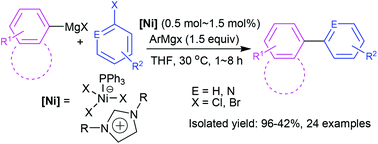Novel ionic Ni(II) complexes of general formula [R2im][Ni(PPh3)Cl3] (R2im = 1,3-bis(2,6-diisopropylphenyl)imidazolium cation, IPrim, 1a; R2im = 1,3-diisopropylimidazolium cation, iPrim, 2a) were easily prepared in high yields by the direct reaction of Ni(PPh3)2Cl2 with 1 equiv. of N,N′-dihydrocarbylimidazolium salt, [R2im]Cl. Their bromide analogs [R2im][Ni(PPh3)Br3] (R2im = IPrim, 1b; R2im = iPrim, 2b) were synthesized by the same reaction in the presence of excess NaBr. The reaction of Ni(DME)Cl2 (DME = 1,2-dimethoxyethane) with 2 equiv. of [IPrim]Cl led to the formation of the complex [IPrim]2[NiCl4] (3) in an almost quantitative yield. All these complexes were characterized by elemental analysis, electrospray ionization mass spectrometry (ESI-MS), and 1H NMR spectroscopy; X-ray crystallography was performed for 1a, 1b, 2a, and 2b. A catalytic study of the cross-coupling reactions of aryl Grignard reagents with aryl halides revealed that complexes 1a and 1b possessed the highest activities. In comparison, complexes 2a, 2b, 3, and the related biscarbene Ni(II) complex Ni(IPr)2Cl2 [IPr = 1,3-bis(2,6-diisopropylphenyl)imidazol-2-ylidene] exhibited moderate activities; the least active complexes were Ni(PPh3)2Cl2 and [NEt4][Ni(PPh3)Cl3].

